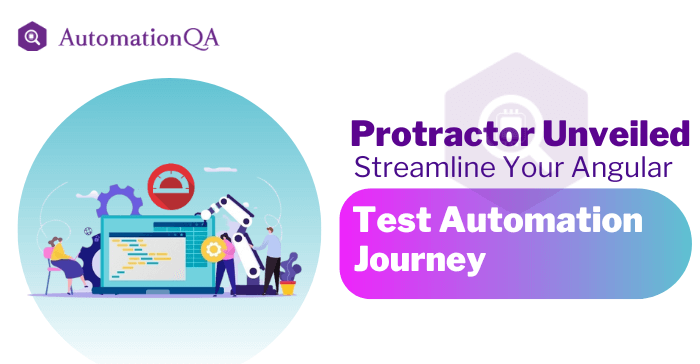
Is your web application built using Angular? And you’re on a quest to conquer the challenges of automation testing? Then dive deeper into this article, where we explore the fascinating world of test automation using Protractor.
Although automation testing of angular applications is challenging due to its dynamic nature, it must support its significance. It improves the quality of the application by eliminating the chances of human error. It allows QA automation companies to widen their test conversion and cost-effectively reduce the time to market.
“Effortlessly conquer Angular app testing with Protractor’s automation power!”
Buckle up to level up your Angular app testing with Protractor.
Why Do QA automation companies Need Protractor Framework?
The majority of web applications utilize JavaScript, a programming language that is highly popular and widely employed. However, the size of the JavaScript also increases with the program’s complexity. Consequently, testing the program in different settings becomes difficult for a tester.
This is precisely where Protractor comes to your rescue. It is a JavaScript-based NodeJS application explicitly designed for automating tests of AngularJS apps. The framework can identify advanced HTML attributes and perform, making it an invaluable tool for web developers and testers. It also has built-in support for Angular’s testing APIs, making writing robust and reliable tests for Angular applications easy.
Protractor Architecture: How does it work?
Protractor is an automation testing framework wrapped around Selenium WebDriverJS. The architecture of Protractor relies on a concept called “Control Flow.” It manages the control flow between test stages using asynchronous JavaScript programming. It allows the Protractor to handle asynchronous operations, such as waiting for items to load.
Protractor delivers Angular-specific functionality and Selenium WebDriver features to make end-to-end testing easier. It also employs a “Page Object Model” (POM) pattern, which allows developers to create reusable page objects that encapsulate the functionality of each page in the application. At its core, Protractor utilizes the WebDriverJS library, a JavaScript binding for the WebDriver API, to interact with web browsers and simulate user actions. Protractor automation services also integrate with the Jasmine testing framework, which provides a clear and concise syntax for writing test cases and assertions.
How to set up Protractor for Test Automation?
It is crucial to initially configure Protractor using the following steps before starting automation testing.
1. Install NodeJS: Use the following commands to verify that NodeJS and npm are correctly installed:
$ node -v
$ npm -v
2. Using npm, install Protractor globally:
npm -g install protractor
You don’t need to install a Protractor (Protractor API) or a default Selenium server web driver manager to launch a standalone server.
3. Enter the following command to check the Protractor’s version and confirm its installation:
version of protractor
4. Before performing test Automation with Protractor, run the following command to update the WebDriver Manager:
Update for web driver-manager
5. Enter the following command to launch the WebDriver Manager in the background.
webdriver-manager start
6. After this, the web driver will automatically submit the test results to Protractor, recognizes the tests, and runs them.
Why use a protractor for automation testing?
- It can Identify Web Elements with advanced HTML attributes.
- It can perform End to End Functional Testing and Cross Browser Testing.
- Protractor supports Real Devices on Cloud, allowing broader coverage.
- It offers flexibility to QA automation companies by supporting different languages for API binding.
- Protractor supports Asynchronous Test Execution.
- It allows Automatic Waiting.
Best Practices in Protractor Testing
- Consider using parallel testing to save time and resources and ensure cross-browser compatibility during cross-browser testing.
- Additionally, to make debugging easier, use text and visual logs to keep track of actions performed with each command.
- Text logs are helpful for record-keeping purposes. Visual logs generate screenshots for every test step, aiding in understanding application behavior and facilitating troubleshooting when the anticipated result is unattainable.
- Users can also record test execution in video format for precise debugging, allowing them to watch what fails and figure out why it failed.
- However, remember that this may lengthen execution time. Therefore, leading QA automation companies use it only where necessary.
- It is unnecessary to strictly monitor tests that pass, as this could slow down operations if many tests need to be executed.
- Remember to always run Protractor Selenium tests on real browsers and devices.
Conclusion
In today’s fast-paced software development landscape, test automation is a critical tool for testers to satisfy the escalating demands of consumers for optimal product quality. To achieve automation testing services for applications using the Angular framework, you must use Protractor.
It has significantly increased the role of QA automation companies in modern software development cycles. They have an expert team to design and implement automated test scripts. So, why are you waiting?
Take advantage of Protractor for seamless and efficient test automation today!
AutomationQA
Latest posts by AutomationQA (see all)
- Cypress in Action: Enhancing Software Testing in Modern Development Practices - October 18, 2024
- Achieving QA Excellence By Implementing Continuous Test Automation for Faster, Better Software - October 10, 2024
- Mastering Mobile App Testing With Top Selenium Best Practices - October 3, 2024
